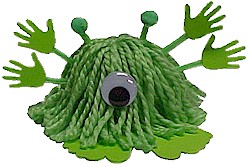
* Empty cereal box
* Scissors
* Pencil
* Duct (or packing) tape
Instructions
Step 1 Cut out the shoe shapes plus as many straps as your child wants. Tape the straps in place using masking, duct, or packing tape. For the best fit, wrap and tape the straps and soles together around the child's bare feet. Kids can leave the sandals au naturel or decorate them with whatever their feet desire. Note: these sandals are best as loungewear as they may be slippery on certain surfaces.







































 And now you don't even need wool to make a pompom, so you can get going on this project right away! An orange sheep... I don't think so, but then plenty of plastic carrier bags come in white, and if you use a black bin liner (refuse sack) then you really could make the black sheep of the family. Yes, a great way to reuse those plastic grocery bags, is by using them to make your pompoms. If you tie off the pompom with more plastic bag, then you can still recycle the finished pompom as if it was a normal plastic bag. You can also use black, white or green dustbin liners, or sandwich bags, which come in a range of subtle colours. Plastic bag pompoms will work for any of the Funky Pompom projects on dadcando. To make them all you do is replace the wool steps with the plastic bag. To make it easier to thread, you might want to cut the bag into wide strips, but as long as you can thread the bag through the centre of the discs then it's ok. A plastic bag pompom has a glossy slippery finish that is much softer than you would imagine and is a good alternative to wool.
And now you don't even need wool to make a pompom, so you can get going on this project right away! An orange sheep... I don't think so, but then plenty of plastic carrier bags come in white, and if you use a black bin liner (refuse sack) then you really could make the black sheep of the family. Yes, a great way to reuse those plastic grocery bags, is by using them to make your pompoms. If you tie off the pompom with more plastic bag, then you can still recycle the finished pompom as if it was a normal plastic bag. You can also use black, white or green dustbin liners, or sandwich bags, which come in a range of subtle colours. Plastic bag pompoms will work for any of the Funky Pompom projects on dadcando. To make them all you do is replace the wool steps with the plastic bag. To make it easier to thread, you might want to cut the bag into wide strips, but as long as you can thread the bag through the centre of the discs then it's ok. A plastic bag pompom has a glossy slippery finish that is much softer than you would imagine and is a good alternative to wool. 





 Cut about eight 1" x 24" strips out of the same paper. Beginning close to the bottom of basket, weave one of these strips in and out of the radiating strips all the way around the basket. Cut off or add extra piece to complete first woven level. Secure ends with tacky glue. Weave two or three more levels.
Cut about eight 1" x 24" strips out of the same paper. Beginning close to the bottom of basket, weave one of these strips in and out of the radiating strips all the way around the basket. Cut off or add extra piece to complete first woven level. Secure ends with tacky glue. Weave two or three more levels.




